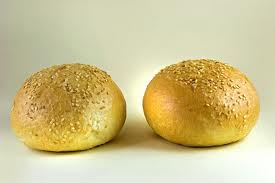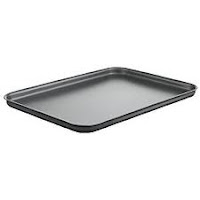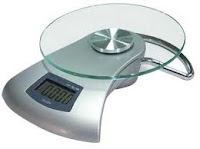Bread
Uwielbiam go i od kilku lat sama piekę. Uwielbiam go wyrabiać i patrzeć jak rośnie. No i mamy pierwsze słowo – wyrabiać chleb, czyli KNEAD BREAD. Tak, dzisiaj będzie o chlebie…
Chleb lub pieczywo to po angielsku BREAD. Możemy sami piec lub kupić w piekarni- BUY BREAD AT THE BAKER’S
Ale to prościzna.
 |
| Wheat bread |
Nie każdy już natomiast pamięta, że chleb jest w języku angielskim niepoliczalny (UNCOUNTABLE), co oznacza, że nie możemy utworzyć liczby mnogiej od BREAD i powiedzieć BREADS. Możemy za to policzyć bochenki, czyli LOAVES. Bochenek to LOAF (l.poj), w liczbie mnogiej zamienia nam sie f na v i stąd mamy LOAVES.
Joe! Be a pet and buy me two loaves of bread.
Joe! Bądź taki dobry i kup mi dwa bochenki chleba.
Można też policzyć kromki chleba, czyli SLICES OF BREAD.
Ok, najlepszy chleb jest podobno świeży – FRESH BREAD taki z chrupiącą skórką- WITH CRUST, najlepiej posmarowany samym masłem: FRESH BREAD WITH BUTTER. Smarować chleb masłem to BUTTER BREAD:
Could you butter this slice for me?
Czy mógłbyś posmarować mi tę kromkę masłem?
Znam takich, którzy za piętkę lub przylepkę oddaliby wszystko, a piętka to HEEL albo END CRUST OF A LOAF.
No, ale czerstwy chleb- STALE BREAD też można jeszcze spożytkować, np. do sporządzenia zaczynu- LEAVEN na następny chleb.
 |
| Leaven |
Rodzajów chleba jest ogromna ilość, prawdopodobnie tyle ile rodzajów mąki, czyli FLOUR, ale te najpopularniejsze to:
 |
| Wholemeal bread |
WHITE BREAD- biały chleb
WHEAT BREAD- chleb pszenny
WHOLEMEAL BREAD- chleb razowy
WHOLEGRAIN BREAD- chleb pełnoziarnisty
SOURDOUGH BREAD- chleb na zakwasie
CRISPBREAD- chleb chrupki (to te wszystkie wasy i inne wafelki ;)
RYE BREAD- chleb żytni
CORN BREAD- chleb kukurydziany
SPELT BREAD- chleb orkiszowy
GLUTEN-FREE BREAD-chleb bezglutenowy
 |
| Rolls |
Bułka to ROLL albo BUN. ROLL to taka zwykła, natomiast jesli jest okrągła lub słodka to juz jest BUN. A nasza przysłowiowa bułka z masłem na określenie czegoś szalenie prostego, wręcz banalnego to po angielsku kawałek ciasta, czyli- A PIECE OF CAKE:
That exam was a piece of cake. I passed it easily.
Ten egzamin to była bułka z masłem. Zdałem go z łatwością.
 |
| Buns |
Chleb używany jest przez nas w bardzo wielu wyrażeniach frazeologicznych, chociażby wcześniej wspomniana już bułka z masłem – A PIECE OF CAKE. Możemy mówić o chlebie powszednim – BREAD AND BUTTER lub NOTHING UNUSUAL. BREAD AND BUTTER używamy w znaczeniu chleb powszedni mając na mysli środki do życia np. tak:
Tourism is the island’s bread and butter.
Turystyka dostarcza wyspie podstawowych środków do życia.
NOTHING UNUSUAL będzie to bardziej chleb powszedni w znaczeniu codzienna rzecz, nic specjalnego:
Fighting with fire is nothing unusual for firefighters.
Walka z ogniem to dla strażaków chleb powszedni.
Jesli nasza praca nie wymaga od nas zbyt dużo wysiłku i raczej się przy niej nie wysilimy a coś nie coś i tak przy tym zarobimy, to mówimy że jest lekka, a po angielsku- EASY MONEY lub MONEY FOR JAM:
I work 4 hours a day and have no stress so it’s easy money/money for jam!
Pracuję cztery godziny dziennie i nie mam wcale stresu., więc to jest lekka praca/ łatwa robota.
Z drugiej strony mówimy, że coś jest ciężkim kawałkiem chleba, czyli- A HARD WAY TO EARN A LIVING:
Mary says that being a nurse is a hard way to make a living.
Mary mówi, że bycie pielęgniarką to ciężki kawałek chleba.
 |
| Break bread |
Chlebem się łamiemy – BREAK BREAD:
Let us break bread together.
Przełammy się chlebem.
Czasem żyjemy o chlebie i wodzie- LIVE ON BREAD AND WATER:
After the surgery she lived on bread and water, as she couldn’t eat properly.
Po operacji żyła o chlebie i wodzie ponieważ nie mogła jeść normalnie.
Innymi razy mówimy, że ktoś z niejednego pieca chleb jadł- HE’S SEEN QUITE A FEW THINGS albo HE’S KNOCKED AROUND A BIT.
Jest też powiedzenie mówiące, że nie samym chlebem człowiek żyje- MAN CANNOT LIVE BY BREAD ALONE.
Simple bread recipes:
Cranberry spelt bread
Orkiszowy chleb z żurawiną
That’s delicate bread with nice cranberry and orange zest aroma. I don’t remember where I found the recipe, but must tell you I’ve been making it for some months now and I’m nowhere near getting bored with it. It’s easy to make and addictive ;)
Ingredients:
 |
| My loaf today |
75 g porridge oats (płatki owsiane)
175 g dried cranberries (suszona żurawina)
450 g spelt flour (mąka orkiszowa)
1½ teaspoons of salt
½ teaspoon of cinnamon
fine orange or clementine zest (starta skórka z pomarańczy lub klementynki)
50 g melted butter (roztopione masło)
1 teaspoon of dried yeast (drożdże suszone) or (preferably) 15-20 g of fresh yeast (świeże drożdże)
some olive oil for kneading
Method:
Put porridge oats and cranberries into a bowl and cover them with 375 ml hot water. Allow it to soak and cool a little.
In a big bowl mix flour, salt, cinnamon and orange zest. Add butter, yeast and cranberries with porridge oats. If you’re using fresh yeast, as I prefer, first before adding it to the mixture cover it with a teaspoon of sugar in a cup and wait till it melts, add 2 or 3 spoonfuls of warm milk or water, mix it until it blends and then add to the mixture.
Mix everything well together and leave the mixture to rest for 10 minutes. Oil your hands and knead the bread for 1 minute, leave it to rest for 10 minutes and knead once more. Then repeat kneading once or two times. I usually knead bread in a bowl but you can also do it on a wooden breadboard. The dough should be elastic and smooth.
Cover the dough with a cloth and let rise in a warm place for 30-60 minutes. After many (believe me MANY) unsuccessful attempts to bake bread I finally found the way to do it in my kitchen. I had always had problems with rising bread until I started to put it next to a pot with boiling water. Problems with rising disappeared and it rises easily. Don’t forget to close the window, as yeast dough doesn’t like draft.
 When the dough has doubled in volume place it in a loaf pan with baking paper in it and leave to rise for about an hour or more if necessary.
When the dough has doubled in volume place it in a loaf pan with baking paper in it and leave to rise for about an hour or more if necessary. Preheat the oven to 220 degrees C. Bake bread for about 50 minutes.
Simple Italian ciabatta rolls
Proste włoskie ciabatty
 |
| These are mine baked today |
Pre-ferment (biga; zaczyn)
1/3 cup water
½ teaspoons dried yeast
2/3 cup wheat flour ( I use 850 usually)
Mix it all together, cover with a cloth and leave for the night (9-17 hours)
Dough
All of the pre-ferment
1 1/3 cups water
2 teaspoons dried yeast
3 ¼ cups wheat flour
1 ½ teaspoons salt
Mix everything together in a large bowl and knead until the dough is elastic and smooth. Cover the bowl with a cloth and leave to rise in a warm place for about 4-5 hours.
Place the dough on a floured wooden breadboard and gently stretch it to form a rectangle (25x30 cm). Use a sharp knife to cut it into 6 big or 8 small rolls and place them on a big baking tray. Leave it to rise for about 40-60 minutes.
Preheat the oven to 230 degrees C. Place the ciabattas in the heated oven and bake for about 15-20 minutes. If I remember (and I usually do) I place some ice cubes on a tray in the bottom of the oven as well and it makes the ciabattas crustier.









Nie ma to jak domowej roboty chlebuś! Najlepszy prosto z pieca z masełkiem.... Mniam. Mniam
OdpowiedzUsuńThe ciabatta rolls you made look delicious! I love ciabatta rolls, I have to try your recipe. I made bread once, rosemary and garlic and it was not very sucessful! lol
OdpowiedzUsuńYou must try it! It takes TIME at the beginning but it's truly worth it. Once you start successfully you'll probably never stop :))
OdpowiedzUsuń